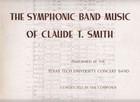
COMPOSED BY CLAUDE SMITH, DEDICATED TO HIS WIFE MAUREEN. PREMIERED BY THE N. CAROLINA BANDMASTERS HONORS BAND IN 1975. MR. SMITH DIED OF A HEART ATTACK IN 1987 AFTER CONDUCTING A CHRISTMAS CONCERT AT HIS CHURCH. PERFORMED BY THE 1977 TEXAS TECH BAND.
highschool bands
jazz bands
college bands
all region bands
community bands
concert bands
honor bands
interlochen arts academy
marching bands
national music camp
tmea all state bands
university bands
Story behind the song
Claude Thomas Smith, a prominent American educator, conductor, and composer, was born in Monroe City, Missouri on March 14, 1932 to Claude Melvin and Harriet Thomas Smith. The family moved twice in Smith's early years: to Kansas City shortly after his birth and to Carrollton, Missouri around the time that he entered school. Smith took dancing lessons in both locations, and began piano lessons and participated in school music and theater productions while living in Carrollton. During this time, his grandmother, a piano teacher and organist, indirectly influenced him through informal musical contact. Smith first participated in band in the eighth grade after receiving a cornet for Christmas. Harold Arehart assumed the band directorship at the Carrollton Schools in 1947, and had a significant influence on Smith who studied cornet with him and served as his assistant. Smith's conducting can be traced to this time, both at high school and with a local Boy Scout band. Claude T. Smith was a prolific composer, having completed over 110 compositions for band, twelve orchestral works, and fifteen choral pieces that were described by one critic as "contemporary romantic." His pitch language is essentially analogous to Western common practice traditions, with particular emphasis on striking melodic material and bass lines that articulate functional harmonic progressions. Multiple scholars have noted, however, that toward the end of his life, Smith was using "dissonances" with increasing frequency and postulated that had he continued writing, this aspect would have become a more pervasive characteristic of his music. Smith is perhaps best known for his rhythmic practice, particularly introducing asymmetrical meters into the band idiom in 1964 with the 7/8 and oddly subdivided 9/8 measures of Emperata Overture. Some of Smith's other compositions feature continually changing meters, such as the 3/4 - 6/8 - 1/4 - 7/8 - 3/4 metrical sequence found in Acclamation. Smith is also recognized for using triplet quarter notes and hemiola techniques in many of his pieces. Taking these two facets in combination, it is apparent that through the majority of his career, Smith's use of pitch was firmly rooted in 19th-century practice, while his rhythmic syntax owed much to certain composers of the early to mid 20th-century such as Igor Stravinsky and Aaron Copland. A final notion that is frequently cited regarding Smith's music is his attention to all ensemble lines; partly stemming from his pedagogical perspective, Smith continually strove to write engaging parts for each member of the ensembles for which he composed, a facet that is particularly apparent in his percussion writing.